


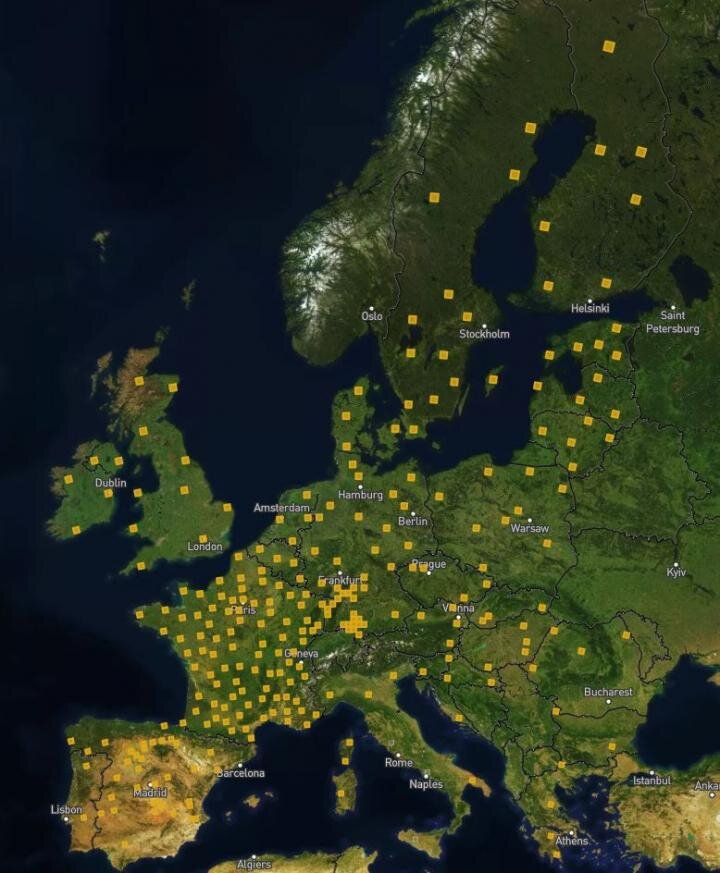


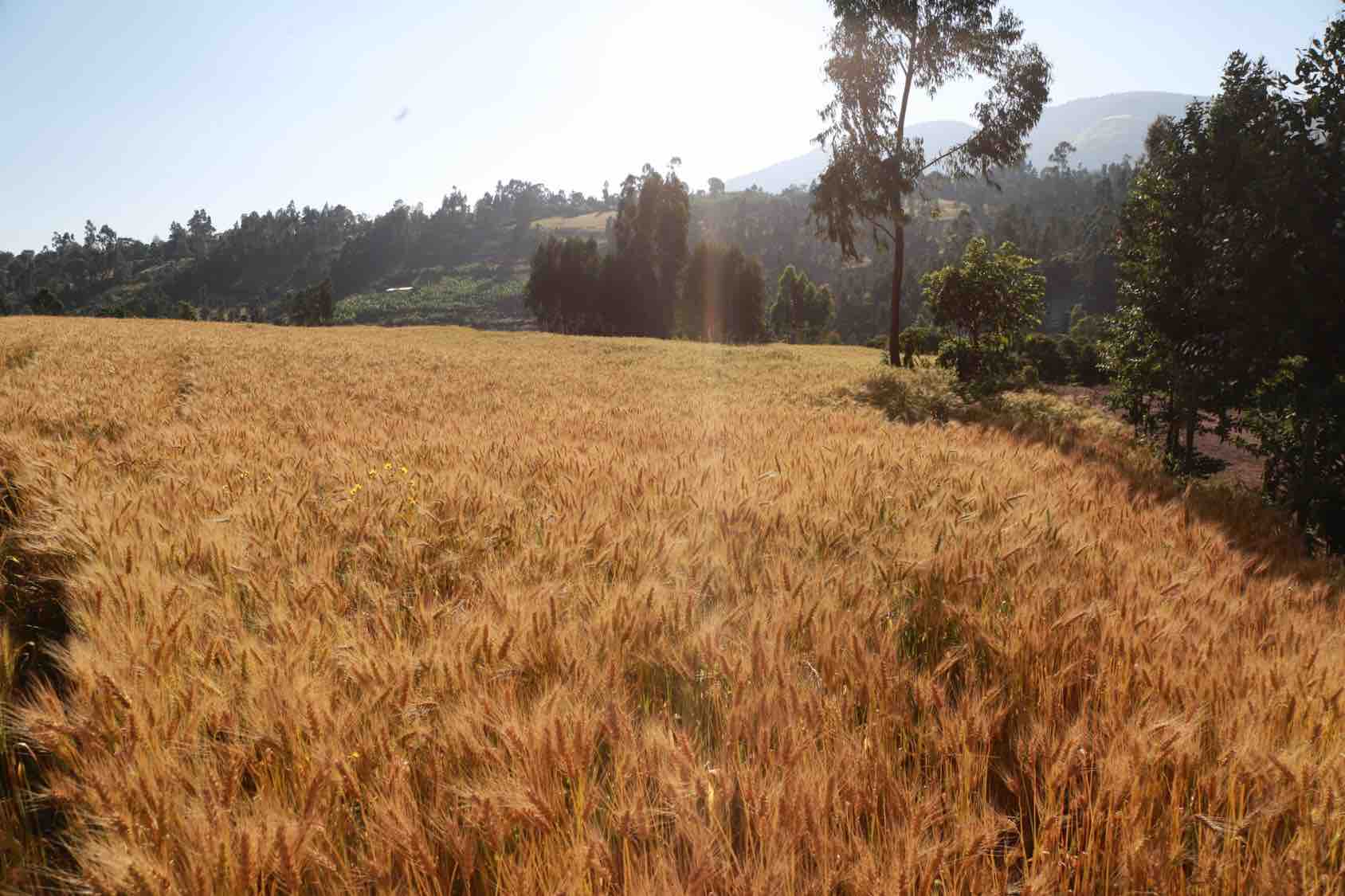
Scientists identified significant new chromosomal regions for wheat yield and disease resistance, which will speed up global breeding efforts.
Using the full wheat genome map published in 2018, combined with data from field testing of wheat breeding lines in multiple countries, an international team of scientists has identified significant new chromosomal regions for wheat yield and disease resistance and created a freely-available collection of genetic information and markers for more than 40,000 wheat lines.
Reported in Nature Genetics, the results will speed up global efforts to breed more productive and climate-resilient varieties of bread wheat, a critical crop for world food security that is under threat from rising temperatures, rapidly-evolving fungal pathogens, and more frequent droughts, according to Philomin Juliana, wheat scientist at the International Maize and Wheat Improvement Center (CIMMYT) and first author of the new study.
“This work directly connects the wheat genome reference map with wheat lines and extensive field data from CIMMYT’s global wheat breeding network,” said Juliana. “That network in turn links to over 200 breeding programs and research centers worldwide and contributes to yield and other key traits in varieties sown on nearly half the world’s wheat lands.”
The staple food for more than 2.5 billion people, wheat provides 20% of human dietary calories and protein worldwide and is critical for the nutrition and food security of hundreds of millions of poor persons in regions such as North Africa and South Asia.
“Farmers and societies today face new challenges to feed rising and rapidly-urbanizing populations, and wheat epitomizes the issues,” said Ravi Singh, CIMMYT wheat breeder and corresponding author of the study. “Higher temperatures are holding back yields in major wheat-growing areas, extreme weather events are common, crop diseases are spreading and becoming more virulent, and soil and water are being depleted.”
Juliana said the study results help pave the way to apply genomic selection, an approach that has transformed dairy cow husbandry, for more efficient wheat breeding.
“Molecular markers are getting cheaper to use; meanwhile, it’s very costly to do field testing and selection involving many thousands of wheat plants over successive generations,” Juliana said. “Genome-wide marker-based selection can help breeders to precisely identify good lines in early breeding generations and to test plantlets in greenhouses, thereby complementing and streamlining field testing.”
The new study found that genomic selection could be particularly effective in breeding for wheat end-use quality and for resistance to stem rust disease, whose causal pathogen has been evolving and spreading in the form of highly-virulent new races.
The new study also documents the effectiveness of the global public breeding efforts by CIMMYT and partners, showing that improved wheat varieties from this work have accumulated multiple gene variants that favor higher yields, according to Hans-Joachim Braun, director of CIMMYT’s global wheat program.
“This international collaboration, which is the world’s largest publicly-funded wheat breeding program, benefits farmers worldwide and offers high-quality wheat lines that are released directly to farmers in countries, such as Afghanistan, that are unable to run a full-fledged wheat breeding program,”
Braun explained.
The study results are expected to support future gene discovery, molecular breeding, and gene editing in wheat, Braun said.
Together with more resource-efficient cropping systems, high-yielding and climate-resilient wheat varieties will constitute a key component of the sustainable intensification of food production described in Strategy 3 of the recent EAT-Lancet Commission recommendations to transform the global food system. Large-scale genomics will play a key role in developing these varieties and staying ahead of climate- and disease-related threats to food security.
Read the paper: Nature Genetics
Article source: CIMMYT
Image: Apollo Habtamu/CIMMYT
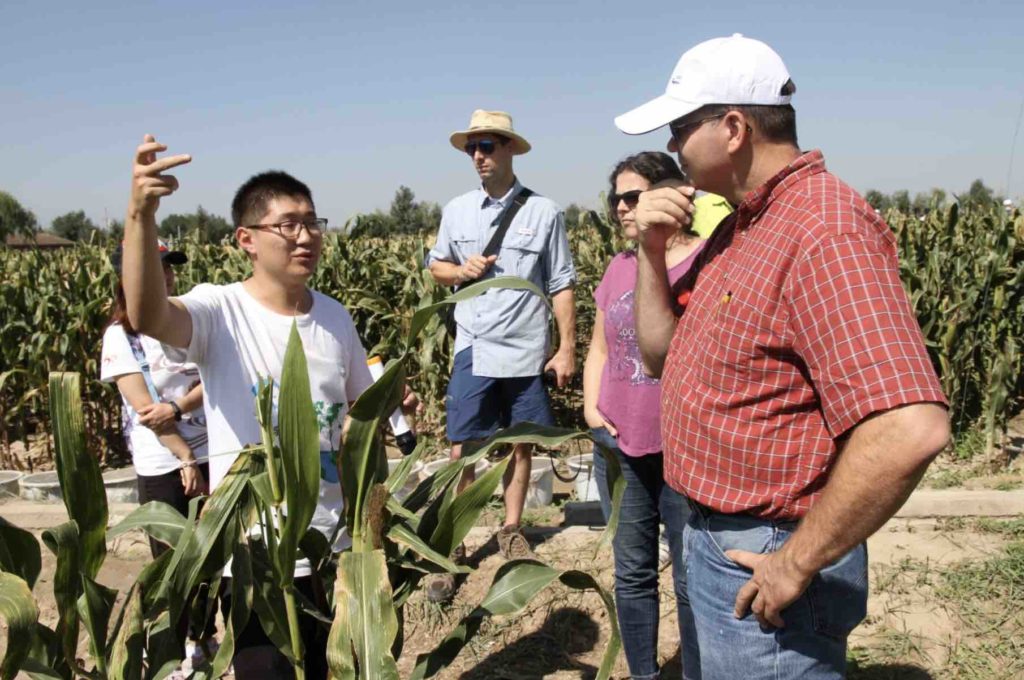
Picture: Dr. Felix Fritschi, University of Missouri, while talking with China Agricultural University graduate students
Authors: Shannon K. King1,4, Jon T. Stemmle2, Robert E. Sharp3,4
1Department of Biochemistry, 2School of Journalism, 3Division of Plant Sciences, and 4Interdisciplinary Plant Group, University of Missouri, Columbia, USA
Second post of our “Global Collaboration” series
Earning a graduate degree in the life sciences is all about preparing students to become productive and competitive in today’s scientific field; ensuring they are at the cutting edge of technology and knowledge. However, one aspect of graduate education that is seemingly overlooked is extending outside of the lab and learning how to become a scientist in the global community. This oversight is something that scientists at the University of Missouri and China Agricultural University are working to combat.
In August 2018, faculty, graduate students and post-docs from both universities came together in Beijing for a workshop to discuss scientific areas of expertise ranging from wetland ecology to crop modeling. This allowed attendees to practice collaborating with other scientists internationally and across disciplines.
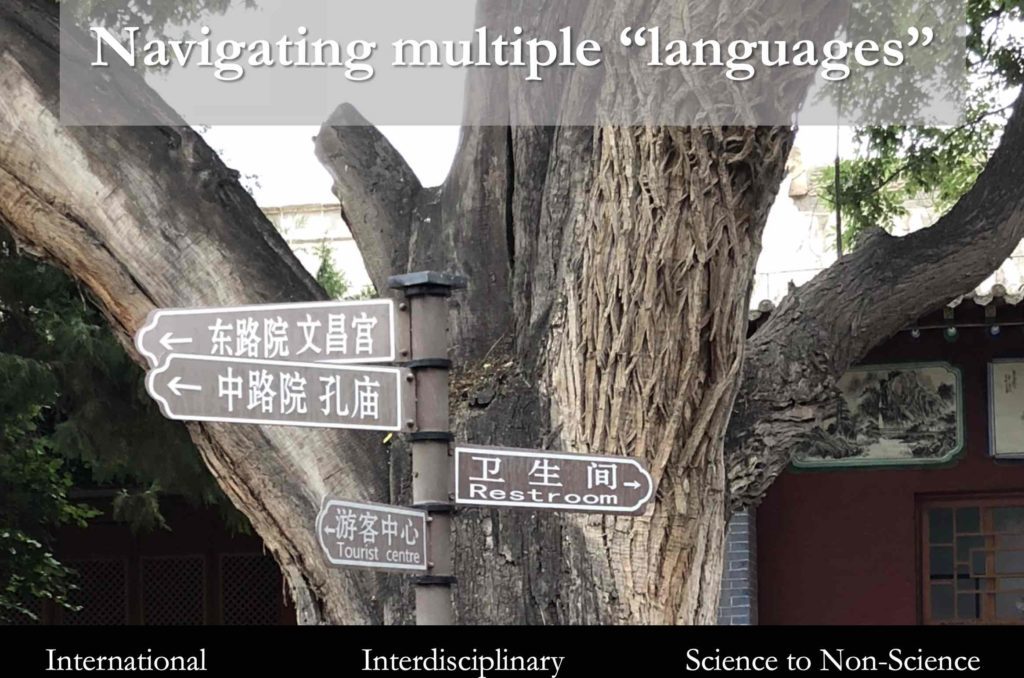
One of the key skills the graduate students developed during the workshop was how to communicate science in multiple languages. The students had to overcome the challenges of communicating science in English and Chinese along with explaining it to scientists outside of their disciplines and then take those experiences and turn them into videos, stories and blog posts that the public could enjoy.
Needless to say, the students quickly learned that not only is science communication difficult, but the degree of difficulty rises exponentially when trying to communicate with an audience outside of your native language and discipline. To tackle the language barrier, students avoided jargon and slowed their speaking pace to clearly articulate their points. Many times, the students from the two universities took the breaks between sessions to really talk to each other about the presentation content to solidify what the takeaways were. It was these informal discussions that led to very productive conversations. Students also pointed out the similarities and differences between their projects, allowing for bridges to be built between what would normally be very different fields.
Another part of this workshop helped the students to learn how to better engage with the general public. While in China, the Missouri graduate students performed journalistic tasks in order to demonstrate what they learned and experienced during the workshop. They took video footage, interviewed workshop attendees and conceptualized how to turn all of that content into stories. When the Missouri students returned home, they began the process of creating content about the China trip. They had to make sure all videos, blogs, and articles were easily understandable to a non-science audience since everything would be eventually posted online at https://rootsindrought.missouri.edu/ and on Youtube.
Through this experience, University of Missouri students were able to take what they had learned in theory and put it into practice. These skills will help them to have a unique advantage compared with their peers and help them as they move into their academic and professional careers.
There is no question that the scientific field is becoming more global and the general public is becoming increasingly skeptical of science. This makes it critical that we begin developing graduate programs to incorporate experiences that allow students to engage in the world outside the lab and learn to communicate why their science is beneficial to society, both at home and abroad.
Supported by NSF Plant Genome Program Grant no. 1444448 to R.E.S. and a 111 Program grant to Prof. Shaozhong Kang, China Agricultural University

The 5th international “Fascination of Plants Day” 2019 (FoPD 2019) is set to be celebrated across the world under the umbrella of the European Plant Science Organisation (EPSO) on the 18th of May. As you know, the goal is to get as many people as possible fascinated by plants and enthused about the importance of plant science. We are happy to announce the Global Plant Council is going to join the FoPD2019 fun by launching two separate online activities during the month of May.
On the one hand, every Friday, starting on the 3rd May, Global Plant Council is planning to publish on its blog a post on the series “Enhancing Global Collaborations in Crop Science” as a follow up on the workshop held in Baltimore last November in the frame of the CSSA/ASA Annual Meeting. First post “State of the art research meets breeding for wheat’s future” has been contributed by Mathew Reynolds, Wheat Physiologist at CIMMYT and leader of Heat and Drought Wheat Improvement Consortium (HeDWIC), the most recent addition to GPC team. Stay tuned for more!
On the other hand, we have another happy announcement to make. Global Plant Council is partnering with the journal “Plant, People and Planet” and launching an online photo contest on plant science that will give all participants the possibility to win one of the three $150 USD prizes. Do you want to know how? it is quite simple.
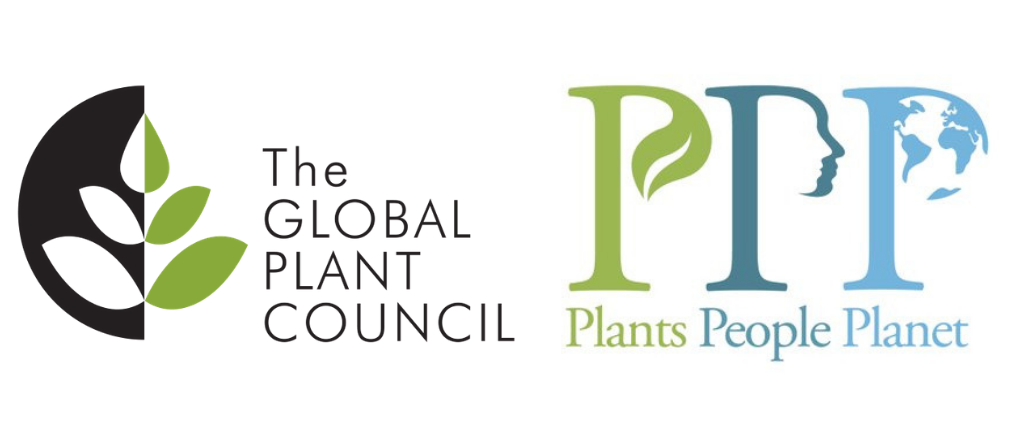
First, obviously, have a photograph/GIF/video taken around any of the following topics:
Secondly, share your photograph/GIF/video with a catchy plant science caption along with BOTH the hashtags #PlantsciART and #PlantDay and mentioning BOTH the Global Plant Council and “Plants, People, and Planet” journal in Twitter (@GlobalPlantGPC @plantspplplanet) OR Instagram (@globalplantcouncil @plantspplplanet).
The FoPD2019 contest will remain open during the month of May, and winners will be announced mid-June. We are eagerly waiting for your contributions and really looking forward to seeing (and sharing!) your pics.
Finally, the blog is back and at full speed. Yuhuuu!
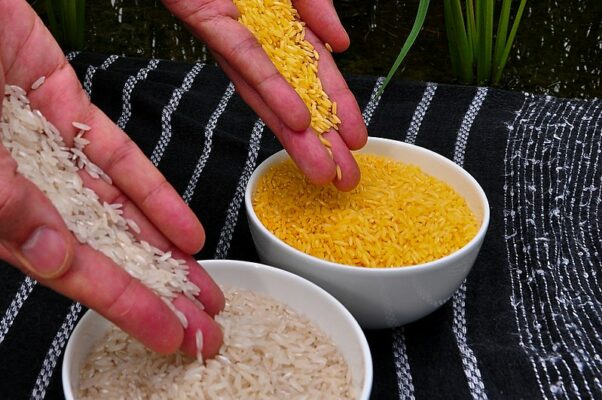
Modified crops such as Golden Rice could have major benefits for people in developing nations. Image credit: IRRI Licensed under CC BY 2.0
By David Zilberman, Professor and Robinson Chair, Agriculture and Resource Economics, UC Berkeley
When I started working on agronomical issues in the 1970s, the most exciting technologies were related to water, machinery, and harvesting. Plant genetics seemed to be quite a boring enterprise. But as I became familiar with the Green Revolution, I realized the importance of plant research, and that the golden rule in agriculture is to find the optimal mixture between biotic and abiotic technologies. As an economist working on technology, I started to realize that the past fifty years have drastically changed the way plant sciences are done, and the potential and value of their product.
The discovery of the innerworkings of a cell, combined with the power of computers and precision tools, has changed medicine, but it has perhaps the potential to make an even bigger impact on plant sciences and agriculture. I have been working on the economics and policy aspects of agricultural biotechnology (see also Journal of Economic Perspectives). Despite the restrictions on genetically modified varieties, they increase yields and make food more affordable for the poor. They also reduce greenhouse gas emissions and actually improved human health (by reducing exposure to chemicals and aflatoxin). But biotechnologies have had limited impact because of regulations that limit their use mostly to feed and fiber crops, and the practical ban on use of GMOs in Europe and parts of Africa.
It’s clear that developing countries can be the major beneficiaries of these technologies. They can save billions of dollars and address severe health and malnourishment problems. Furthermore, applications of biotechnology on food crops can reduce food security problems and increase access to valuable fresh produce throughout the world. Modern biotechnology can provide tools to accelerate adaptation to climate change, and I am surprised that some of the organizations most aware of climate change don’t recognize the value of biotechnology to address it.
Plant science research has already made major achievements using traditional and advanced tools to provide better varieties and improve the global food situation in a world with a fast growing population. There is a large body of literature documenting the rate of return of research, and much of the achievements have been the development of new varieties. The literature suggests that public research that provided much of the benefit has been underfunded, and its funding is declining. Thus, plant research hasn’t reached its potential.
Thus far, applied research in plant sciences at many universities concentrate on grasses, like corn and wheat, but underemphasize trees and algae. One explanation to the emphasis on grasses is the immediate economic benefits they seem to provide. With all the modern tools of biology, the big challenges and some of the most radical and relevant knowledge can come from the study of trees and algae within the context of forest and oceans. Studies of these specimens will enhance our understanding of living systems, is crucially important from a macro-ecological perspective, and from a practical perspective of finding new materials, new foods and efficient sources of energy.

Poplar is one of the most commonly used trees in plant science research. Image credit: Walter Siegmund
I believe that society tends to underinvest in plant sciences, both because science is underfunded in general and because of the regulations of biotechnology that limit their use, as mentioned above. The contribution of plant scientists to address problems of climate change, deforestation, food security, and environmental quality are under-emphasized and under-recognized. This leads to less investment in this area, less contribution, and less student interest. But more investment in plant sciences may provide better understanding of their impact and how to regulate them, and provide more promising applications. So we are in a vicious cycle of over-regulation and under-funding that mostly hurt regions and populations that are vulnerable, and reduce our capabilities to deal with global changes.
To move forward, we need to have more enlightened regulations that will allow us to take advantage of this incredible science and big jolts in terms of support for research in plant sciences. Enlightened regulations would balance benefits and risks, reduce the cost of access to modern biotechnologies. They also would allow efficient and mutually beneficial transfer of knowledge and genetic materials across locations. Plant sciences is one discipline where the distribution of efforts across locations globally can be especially beneficial as we can learn about the performance of plant systems throughout the world. Therefore, investments in plant sciences should be distributed globally. For example, a major effort to raise funding for 100 Chairs of Plant Sciences around the world, especially in developing countries, will be a good start. It should be associated with support for student research, as well as forums the exchange of new ideas. And finally, new investments in arboretums and greenhouses.
Plant sciences have been providing humanity essential knowledge that enabled the growth and evolution of human civilization without much fanfare. New tools increase its potential and the excitement and value of research in these areas. Society needs to expand their support to plant sciences to enable it to flourish around the world, as well as enlightened regulation to gain benefits from the fruits of this research.
 This week we spoke to Dr. Joe Cornelius, the Program Director at the Advanced Research Projects Agency – Energy (ARPA-E). His work focusses on bioenergy production and conversion as a renewable and sustainable energy source, transportation fuel, and chemical feedstock, applying innovations in biotechnology, genomics, metabolic engineering, molecular breeding, computational analytics, remote sensing, and precision robotics to improve biomass energy density, production intensity, and environmental impacts.
This week we spoke to Dr. Joe Cornelius, the Program Director at the Advanced Research Projects Agency – Energy (ARPA-E). His work focusses on bioenergy production and conversion as a renewable and sustainable energy source, transportation fuel, and chemical feedstock, applying innovations in biotechnology, genomics, metabolic engineering, molecular breeding, computational analytics, remote sensing, and precision robotics to improve biomass energy density, production intensity, and environmental impacts.
What is ARPA-E? How are programs created?
The Advanced Research Projects Agency-Energy (ARPA-E) is a young government agency in the U.S. Department of Energy. The agency is modeled on a successful Defense Department program, the Defense Advanced Research Projects Agency (DARPA). Both agencies target high-risk, high-reward research in early-stage technologies that are not yet ready for private-sector investment.
Program development is one of the unique characteristics of the agency. ARPA-E projects are in the hands of term-limited program directors, who develop a broad portfolio of concepts that could make a large impact in the agency’s three primary mission areas: energy security, energy efficiency, and emissions reductions. The agency motto is “Changing what’s possible”, and we are always asking ourselves, “if it works, will it matter?”. Getting a program approved is a lot like a doing a PhD; you survey the field, host a workshop, determine key points to research, define aggressive performance metrics, and finally defend the idea to the faculty. If the idea passes muster, the agency makes a targeted investment. This flexibility was recently noticed as one of the great aspects of ARPA-E culture and is an exciting part of the job.
What is TERRA and how is it new for agriculture?
TERRA stands for Transportation Energy Resources from Renewable Agriculture, and its impact mission is to accelerate genetic gains in plant breeding. This is an advanced analytics platform for plant breeding. Today, significant scientific progress is possible through the convergence of diverse technologies, and TERRA’s innovation for breeders comes through the integration of remote sensing, computer vision, analytics, and genetics. The teams are using robots to carry cameras to the field and then extracting phenotypes and performing gene linkages. It’s really awesome to see.
This is run by the U.S. Department of Energy. How does TERRA tie into energy?
The United States has a great potential to generate biomass for conversion to cellulosic ethanol, but the crops useful for producing this biomass have not seen the improvement that others, such as soybeans or maize, have had. TERRA is focused on sorghum, which is a productive and resilient crop with existing commercial infrastructure that can yield advanced biomass on marginal lands. In addition, sorghum is a key food and feed crop, and the rest of the world will benefit from these advancements.
How does TERRA address the challenge of phenotyping in the field?
The real challenges that remain are in calibrating the sensor output and generating biological insight. A colleague from the United Kingdom, Tony Pridmore, captured the thought well, saying “Photography is not phenotying.” It’s generally easy to take the pictures — unless it’s very windy, the aerial platforms can pass over any crop, and the ground platforms are based on proven agricultural equipment. To get biological insights however, each team requires an analytics component, and a team from IBM is contributing their analytics expertise in collaboration with Purdue University.
What is most exciting about the TERRA program?
We commissioned the world’s biggest agricultural field robot, which phenotypes year-round. The six teams have successfully built other lightweight platforms involving tractors, rovers, mini-bots, and fixed and rotary wing unmanned aerial vehicles. It’s exciting to see some of the most advanced technologies move so quickly into the hands of great geneticists. The amazing thing is how quickly the teams have started generating phenotyping data. I expected it to take years before we got to this point, but the teams are knocking it out of the park, and we are entering into full-blown breeding systems deployment.
Who’s on the TERRA teams? How did you build the program?
ARPA-E system teams include large businesses, startups, and university groups. The program was built to have a full portfolio of diverse sensor suites, robotic platform types (ground and aerial), analytics approaches, and geographic breadth. Because breeders are working for a particular target population of environments, different phenotypes are valued differently across the various geographies. For that reason, each group is collecting its own set of phenotypes. Beyond that, we’ve worked very hard to encourage collaboration across the teams and have an exciting GxE (genotype x environment) experiment running, where several teams plant the same germplasm across multiple geographies. By combining this with high-throughput phenotyping, the teams are in a good position to determine key environmental inputs to various traits.
Once we achieve rapid-fire field phenotyping, what’s next?
We’re going underground! ARPA-E has made another targeted investment, this time in root phenotyping. We’re really excited about this one. It’s a very similar concept, but the sensing is so much harder. The teams have collaborated with medical, mining, aerospace, and defense communities for technologies that can allow us to observe root and soil systems in the field to allow breeders to improve crops. Ask us again next year—we will have some cool updates to both programs!
[LIMA] A joint initiative between NASA and the International Potato Centre (CIP), which is based in Peru, offers scientific evidence that it is possible to grow at least four types of potatoes on Mars.
A scenario starring the root crop was portrayed in the movie “The Martian” (2015), in which a lost astronaut, played by Matt Damon, survives on potatoes he cultivates on the red planet while awaiting rescue.
But in addition to this interplanetary possibility, scientists also observed the crop is genetically suited to adapting to the changes creating more adverse environmental conditions on Earth.
So before turning fiction into reality, the tuber has a mission on Earth.
The study has identified four types of potatoes, out of 65 examined, which have shown resistance to high salinity conditions and were able to form tubers in a type of soil similar to that on Mars.
One of these is the Tacna variety, developed in Peru in 1993. It was introduced to China shortly afterwards, where it showed high tolerance to droughts and saline soils with hardly any need for irrigation.
This variety became so popular in China that it was ‘adopted’ in 2006 under the name of Jizhangshu 8. The same high tolerance was seen on the saline and arid soils of Uzbekistan, a country with high temperatures and water shortages, where the variety was also introduced and renamed as Pskom.
The second variety that passed the salinity test is being cultivated in coastal areas of Bangladesh that have high salinity soils and high temperatures. The other two types are promising clones — potatoes that are being tested for attributes that would make them candidates for becoming new varieties.
These four potato types were created as a result of the CIP’s breeding programme to encourage adaptation to conditions in subtropical lowlands, such as extreme temperatures, which are expected to be strongly affected by climate change.
Down to Earth
In addition to these four potato ‘finalists’, other clones and varieties have shown promising results when tested in severe environmental conditions. The findings offer researchers new clues about the genetic traits that can help tubers cope with severe weather scenarios on Earth.
“It was a pleasant surprise to see that the potatoes that we have improved to tolerate adverse conditions were able to produce tubers on this soil [soil similar to that on Mars],” says Walter Amorós, CIP potato breeder and one of the five researchers involved in the project, who has studied potatoes for more than 30 years.
According to Alberto García, adviser to the UN Food and Agriculture Organization in Peru who is in charge of food security programmes, this experiment “serves to verify that potato, a produce of great nutritional value, is a crop extremely adaptable to the worst conditions”, something that is very relevant for current climate scenarios.
García stresses that global temperatures are now rising at a rate higher than expected, affecting not only potatoes but also other crops. Many now need to be cultivated at higher altitudes — which, he says, is not always a disadvantage and may even be beneficial for crops that were previously cultivated in valleys.
“But it can also have negative consequences that we have to anticipate,” adds García. Therefore, he says this experiment can inspire others to think about future scenarios and look for other crops than can adapt to extreme conditions that will have an impact on agriculture.
The project began with a search for soils similar to that found on Mars. Julio Valdivia-Silva, a Peruvian researcher who worked at NASA’s Ames Research Center, eventually concluded that the soil samples collected in the Pampas de la Joya region of southern Peru were the most similar to Martian soil.
Arid, sterile and formed by volcanic rocks, these soil samples were extremely saline.
Helped by engineers from the University of Engineering and Technology (UTEC) in Lima and based on designs by NASA’s Ames Research Center, the CIP built CubeSat — a miniature satellite that recreates, in a confined environment, a Martian-like atmosphere. This is where the potatoes were cultivated.
“If potatoes could tolerate the extreme conditions to which we exposed them in our CubeSat, they have a good opportunity to develop on Mars,” says Valdivia-Silva.
They then conducted several rounds of experiments to find out which varieties could better withstand the extreme conditions, and what minimum conditions each crop needed to survive.
CubeSat, hermetically sealed, housed a container with La Joya soil, where each one of the tubers was cultivated. CubeSat itself supplied water and nutrients, controlled the temperature according to that expected at different times on Mars, and also regulated the planet’s pressure, oxygen and carbon dioxide levels.
Cameras were installed to record the process, broadcasting developments on the soil and making it possible to see the precise moment in which potatoes sprouted.
Based on the results, CIP scientists say that in order to grow potatoes on Mars, space missions will have to prepare the soil so it has a loose structure and contains nutrients that allow the tubers to obtain enough oxygen and water.
In a next phase of the project, the scientists hope to expose successful varieties to more extreme environmental conditions. This requires, among other things, developing a prototype satellite similar to CubeSat that can replicate more extreme conditions with greater precision, at a price tag of US$ 100,000.
This piece was produced by SciDev.Net’s Latin America and Caribbean desk.
This article was originally published on SciDev.Net. Read the original article.